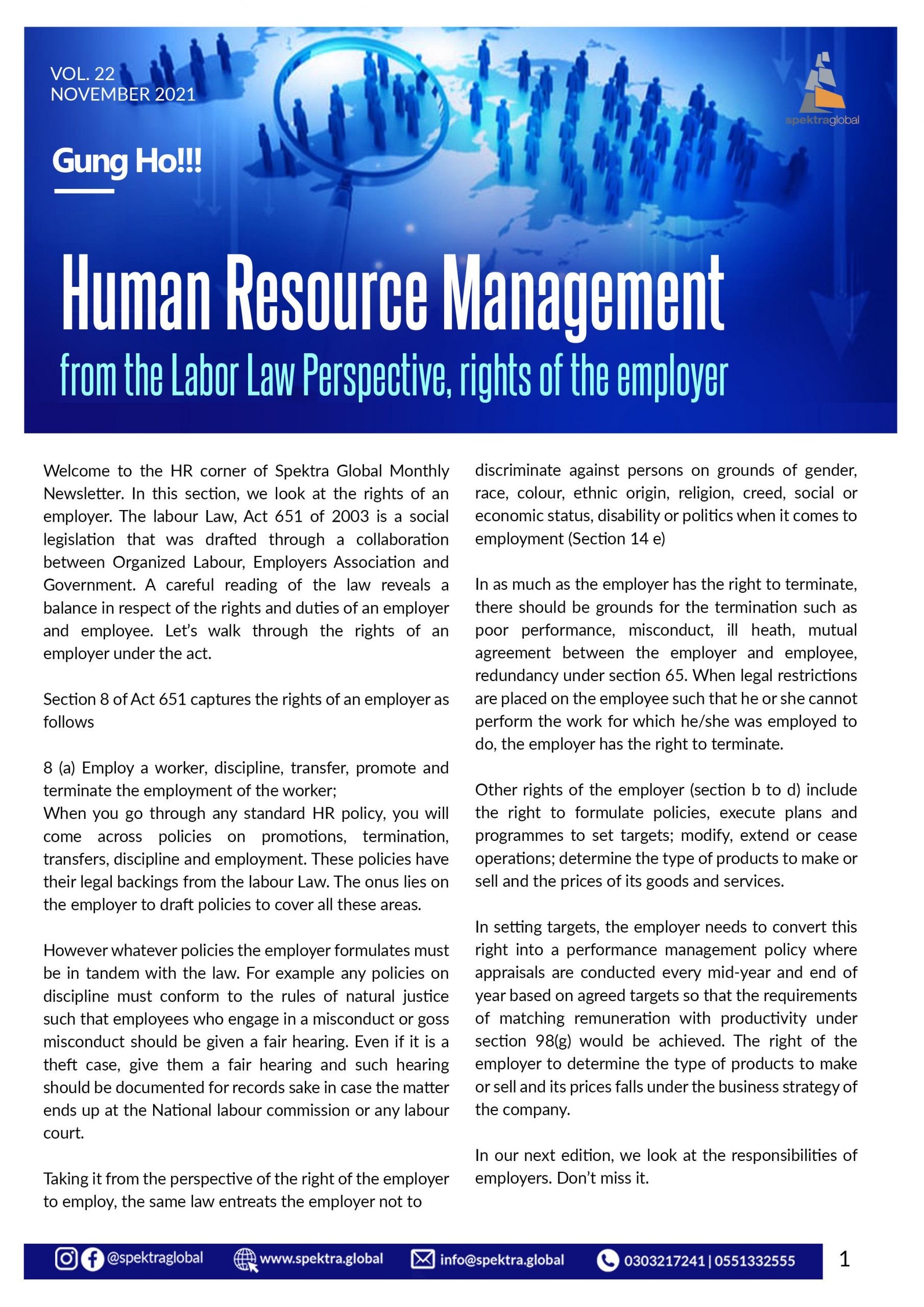
GUNG HO!: Human Resource Management from the Labor Law Perspective, rights of the employers
Welcome to the HR corner of Spektra Global Monthly Newsletter. In this section, we look at the rights of an employer. The labour Law, Act 651 of 2003 is a social legislation that was drafted through a collaboration between Organized Labour, Employers Association and Government. A careful reading of the law reveals a balance in respect of the rights and duties of an employer and employee. Let’s walk through the rights of an employer under the act.
Section 8 of Act 651 captures the rights of an employer as follows 8 (a) Employ a worker, discipline, transfer, promote and terminate the employment of the worker; When you go through any standard HR policy, you will come across policies on promotions, termination, transfers, discipline and employment. These policies have their legal backings from the labour Law. The onus lies on the employer to draft policies to cover all these areas.
However whatever policies the employer formulates must be in tandem with the law. For example, any policies on discipline must conform to the rules of natural justice such that employees who engage in a misconduct or goss misconduct should be given a fair hearing. Even if it is a theft case, give them a fair hearing and such hearing should be documented for records sake in case the matter ends up at the National labour commission or any labour court.
Taking it from the perspective of the right of the employer to employ, the same law entreats the employer not to discriminate against persons on grounds of gender, race, colour, ethnic origin, religion, creed, social or economic status, disability or politics when it comes to employment (Section 14 e)
In as much as the employer has the right to terminate, there should be grounds for the termination such as poor performance, misconduct, ill heath, mutual agreement between the employer and employee, redundancy under section 65. When legal restrictions are placed on the employee such that he or she cannot perform the work for which he/she was employed to do, the employer has the right to terminate.
Other rights of the employer (section b to d) include the right to formulate policies, execute plans and programmes to set targets; modify, extend or cease operations; determine the type of products to make or sell and the prices of its goods and services.
In setting targets, the employer needs to convert this right into a performance management policy where appraisals are conducted every mid-year and end of year based on agreed targets so that the requirements of matching remuneration with productivity under section 98(g) would be achieved. The right of the employer to determine the type of products to make or sell and its prices falls under the business strategy of the company. In our next edition, we look at the responsibilities of employers. Don’t miss it.
Section 8 of Act 651 captures the rights of an employer as follows 8 (a) Employ a worker, discipline, transfer, promote and terminate the employment of the worker; When you go through any standard HR policy, you will come across policies on promotions, termination, transfers, discipline and employment. These policies have their legal backings from the labour Law. The onus lies on the employer to draft policies to cover all these areas.
However whatever policies the employer formulates must be in tandem with the law. For example, any policies on discipline must conform to the rules of natural justice such that employees who engage in a misconduct or goss misconduct should be given a fair hearing. Even if it is a theft case, give them a fair hearing and such hearing should be documented for records sake in case the matter ends up at the National labour commission or any labour court.
Taking it from the perspective of the right of the employer to employ, the same law entreats the employer not to discriminate against persons on grounds of gender, race, colour, ethnic origin, religion, creed, social or economic status, disability or politics when it comes to employment (Section 14 e)
In as much as the employer has the right to terminate, there should be grounds for the termination such as poor performance, misconduct, ill heath, mutual agreement between the employer and employee, redundancy under section 65. When legal restrictions are placed on the employee such that he or she cannot perform the work for which he/she was employed to do, the employer has the right to terminate.
Other rights of the employer (section b to d) include the right to formulate policies, execute plans and programmes to set targets; modify, extend or cease operations; determine the type of products to make or sell and the prices of its goods and services.
In setting targets, the employer needs to convert this right into a performance management policy where appraisals are conducted every mid-year and end of year based on agreed targets so that the requirements of matching remuneration with productivity under section 98(g) would be achieved. The right of the employer to determine the type of products to make or sell and its prices falls under the business strategy of the company. In our next edition, we look at the responsibilities of employers. Don’t miss it.





